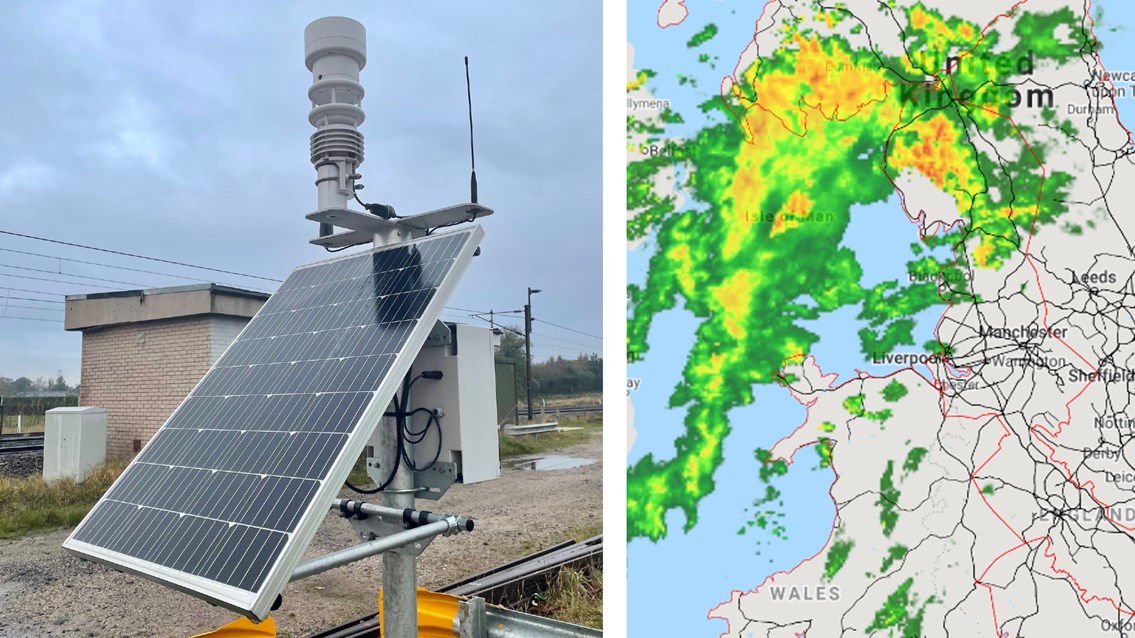Monday 8 Nov 2021
New solar powered weather watching tech keeps passengers moving
- Region & Route:
- North West & Central
Sixty sustainably powered weather stations are now monitoring the railway between London Euston and Carlisle to keep passengers and freight moving safely.
Network Rail has installed the solar-powered weather watchers on the West Coast main line and across parts of the North West so engineers can react fast before and during extreme weather events.
The £1.3m investment gives staff access to real-time data so response teams can be sent to the right place at the right time to fix the railway rapidly.
The scientific surveillance stations measure:
- Wind speed & direction
- Wind gust & direction
- Air temperature
- Relative humidity
- Dew point
- Rain fall totals** (precipitation rate & accumulation)
In the longer term the data gathered will help Network Rail weather experts to predict which parts of the network are more vulnerable to bad weather before it even hits.
Talisa Fletcher, Network Rail service delivery manager, said: “With extreme weather incidents increasing we’ve invested £1.3m to improve our weather monitoring capabilities on the West Coast main line and in the north west.
“Our solar powered weather stations will help us to better understand weather patterns and during stormy weather we can send our response teams to where they’re most needed which will help us to reduce disruption and keep passengers safe.”
Since 2015 in Network Rail’s North West and Central region*, extreme weather has caused half a million minutes of train delays – or more than 400 days.
As the COP 26 opened in Glasgow just last week, thousands of West Coast main line passengers and rail engineers felt the weather’s wrath as a month’s rainfall lashed the railway in the space of a few hours.
This led to speed restrictions and emergency railway closures causing major disruption for passengers.
But this innovative new technology aims to better prepare Network Rail to stay one step ahead of our changing climate, reducing delays so it can get people and goods to where they need to be.
Rail travel is the greenest form of public transport – one passenger train can take up to 500 cars off the road, and one freight train is equivalent to an average of 76 lorries.
For more on how Network Rail manages extreme weather visit: www.networkrail.co.uk/running-the-railway/looking-after-the-railway/responding-to-weather-impacts-on-the-railway/
To read more about the rail industry’s We Mean Green campaign visit: www.networkrail.co.uk/stories/we-mean-green/
Contact information
Passengers / community members
Network Rail national helpline
03457 11 41 41
Latest travel advice
Please visit National Rail Enquiries
Journalists
Network Rail press office - North West & Central Region
0330 854 0100
NWCmediarelations@networkrail.co.uk
About Network Rail
We own, operate and develop Britain's railway infrastructure; that's 20,000 miles of track, 30,000 bridges, tunnels and viaducts and the thousands of signals, level crossings and stations. We run 20 of the UK's largest stations while all the others, over 2,500, are run by the country's train operating companies.
Usually, there are almost five million journeys made in the UK and over 600 freight trains run on the network. People depend on Britain's railway for their daily commute, to visit friends and loved ones and to get them home safe every day. Our role is to deliver a safe and reliable railway, so we carefully manage and deliver thousands of projects every year that form part of the multi-billion pound Railway Upgrade Plan, to grow and expand the nation's railway network to respond to the tremendous growth and demand the railway has experienced - a doubling of passenger journeys over the past 20 years.
Follow us on Twitter: @networkrail
Visit our online newsroom: www.networkrailmediacentre.co.uk

